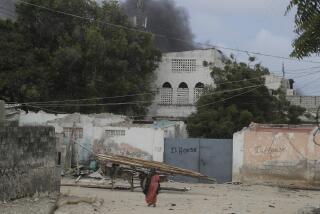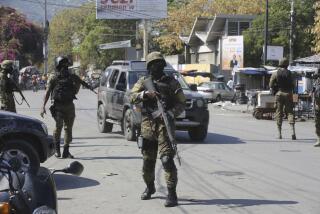Marines Reopen Airport to Aid; Somalis Cheer 1st Relief Flight : Famine: Patrols retake looted U.S. Embassy and stage show of force to deter any opposition. Thousands pour into streets freed of guns.
- Share via
MOGADISHU, Somalia — Just hours after coming ashore Wednesday, U.S. Marines reopened the Mogadishu airport to its first relief flight in weeks, launched urban patrols through this battle-scarred city and, in an act of clear symbolism, took over the abandoned and looted U.S. Embassy compound and raised the Stars and Stripes.
“We raised the flag,” said Sgt. Shawn Blakie, 23, part of the contingent that entered the embassy, which was evacuated in January, 1991. He paused. “It’s sure pretty watching that thing fly.”
The overwhelming majority of Somalis in the capital appeared to agree on the first full day of the U.S.-led, U.N.-sanctioned Operation Restore Hope. Thousands of men, women and children poured into the streets, which were virtually free of guns for the first full day in nearly two years. They appeared at the airport and on surrounding hillsides, cheering when the first relief flight in two weeks arrived.
In a show of force designed to intimidate potential foes, Marine attack helicopters circled the capital at treetop level throughout the day, escorting Marine convoys and inspecting potential trouble spots.
The initial 1,700-member Marine contingent, expected to grow to 28,000 within days, was joined by an advance force of crack French combat troops who immediately began patrolling Mogadishu’s streets by night. The joint mission is to enforce order in a nation ruled by anarchy and enable massive donations of food to reach an estimated 2 million Somalis at risk of starvation in the countryside.
A C-130 Hercules cargo plane carrying 12 tons of high-protein food supplements arrived in the newly secured airport--the beginning of ambitious aid plans that include Marine-escorted food convoys, expected to begin as early as today.
“Things are moving very, very quickly now,” said Rick Grant, spokesman for CARE, which said it will run a 10-truck convoy carrying 50 tons of rice, beans and oil today to isolated areas north of Mogadishu.
In other developments Wednesday:
* Thousands of troops began to depart from Southern California as the United States, having secured key staging areas in Mogadishu, stepped up the scale of the operation. For many of the families, the departures offered a bittersweet moment: They knew their loved ones were off to assist some of the world’s neediest people. But their departure was especially wrenching because it was occurring during the holiday season.
* Military and media officials engaged in a sharp exchange over who was to blame for the circus-like atmosphere that prevailed before dawn Wednesday when American reconnaissance forces landed on Somali beaches only to find themselves besieged by broadcast crews with glaring lights. The Pentagon said the media had acted irresponsibly, potentially endangering troops; network executives said they had complied with all military regulations and had ventured only where they were told they could.
* Saudi Arabia decided to send a troop battalion and air units to Somalia in its first foreign deployment since the mid-1970s, sources in Riyadh said. King Fahd made the decision to commit up to 1,000 troops and ordered Prince Bandar ibn Sultan, Saudi Arabia’s U.S. ambassador, to notify American officials Wednesday.
Diplomatic sources said the Saudis, whose only previous outside deployment was a small contingent of peacekeepers in Lebanon, decided to reverse years of policy as a sign of support for international cooperation in solving global crises.
Order from Chaos
In Mogadishu, the Marines also took control of the port, and aid agencies said that would allow them to resume delivery of 18,000 tons of food held hostage in warehouses there by armed gunmen who have looted up to 90% of the relief food in the country. The U.N. World Food Program also has 30,000 tons of food on four ships that have been reluctant to dock here.
“The city itself is obviously totally different today than yesterday,” said Paul Mitchell, of the World Food Program. “It’s a totally different world out there. Yesterday, you couldn’t go out without a hired gun.”
Mitchell and several other veterans of the long-stymied relief effort conceded that most of the guns were simply hidden at home and that some of the gunmen fled to the country’s interior, where the famine that has claimed 300,000 lives has exacted its biggest toll.
“Yes, we’ve gotten past the first big hurdle,” Mitchell said. But Somalia, he added, “is the kind of place where one day everything goes good; the next day everything falls apart.”
There were isolated reports of sniper fire directed at Marines, including during the embassy seizure, and at the 500-person U.N. peacekeeping contingent. But no one was reported injured, and, after the initial taking of the port and airport, no American shots were fired.
In the capital, a civilian employee was shot in the arm outside U.N. headquarters. There was no word on who was responsible.
Marines set up roadblocks in some areas, confiscating weapons. Under the ground rules covering use of force in their mission, Marines may fire on anyone exhibiting “hostile intent,” whether they fire or not.
Col. Greg Newbold, the operation commander, said the Marines had not expected heavy resistance to their initial landing. But, echoing the assessment of Western relief workers in Mogadishu, he added: “They may not test us in the beginning. But I think they will test us later.”
Newbold also said his soldiers do not plan to take sides in the long, complex internal conflict in Somalia, which has had no functioning government for nearly two years. Mogadishu, for instance, is divided by a “green line” between armed forces loyal to competing warlords Mohammed Farah Aidid and Ali Mahdi Mohamed.
But Aidid and Mahdi do not exert control over the country’s many armed clans.
“If an individual or vehicle shows hostile intent, we will take action,” Newbold said. “We can disarm it or we can vaporize it.
“But we would much prefer it if they smiled when we smiled,” he added.
Although Newbold’s troops were met with thousands of smiles throughout the day as they patrolled the city in convoys of armored vehicles and heavily armed troop carriers, relief officials in the capital were wary of prospects for the joint humanitarian-military mission in the countryside, where its ultimate success or failure will be determined.
Key cities, including Bardera and Baidoa, have in recent days reported renewed fighting among clans. And guarding convoys into those areas in the coming days will present a more difficult challenge for the Marines.
On Wednesday afternoon, the Marines launched their largest foray outside the port and airport, sending a heavily armed, dozen-vehicle detachment to the once-elegant U.S. Embassy compound. The grounds, which include a nine-hole golf course, were gutted two years ago after the fall of President Mohamed Siad Barre. Now they are to become the headquarters of military operations.
Minutes after storming the compound, Marine Maj. Samuel Perez shimmied up the flagpole atop the embassy to reinstall the rope and raise the American flag.
The Pentagon View
In Washington, the Pentagon’s senior military planners Wednesday pronounced the situation in Mogadishu “satisfactory.” But they cautioned that as American troops move on to their secondary targets outside the capital, they may encounter greater difficulties than they did during their landing early Wednesday morning.
House-to-house searches around the security zones established by the landing forces turned up guns in “onesies and twosies,” said Marine Corps Lt. Gen. Martin Brandtner, operations director for the Joint Chiefs of Staff. That is mostly what Pentagon officials expect from gunmen not under the control of clan leaders.
“I hope . . . that it will continue to be a bloodless operation,” said Brandtner. “We must understand, however, that we’re dealing with an extremely dangerous situation. We have a lack of any form of civil control in this area. The risk here is of individuals moving about that are armed, that are not possessed necessarily of sound judgment, so there is an enormous potential for any type of event to occur.”
The Pentagon also said that the initial Marine contingent numbered 1,700 troops, rather than 1,800 as previously reported.
Three ships loaded with Marine equipment are scheduled to arrive off Somalia today.
Meanwhile, U.S. reconnaissance teams are considering whether to extend their operations to Baidoa, as expected, or switch to an airfield just inland from Mogadishu in a town named Bela Dogl.
Baidoa has been racked by clan warfare that has reportedly killed 48 people in the past several days. That strife “seems to have subsided, and we have reports now that the security situation in Baidoa is beginning to right itself, so to speak,” said Rear Adm. Michael Cramer, the Joint Chiefs of Staff’s senior intelligence analyst.
Lt. Gen. Robert B. Johnston and his headquarters staff are expected to leave the Central Command’s headquarters in Florida as early as today to establish their headquarters at the U.S. Embassy compound. Brandtner said Johnston will join Robert Oakley, President Bush’s special envoy to Somalia, in talks with clan leaders aimed at eliminating any resistance to the operation.
The Army’s 10th Mountain Division is expected to leave its home in Ft. Drum, N.Y., in the coming days as Mogadishu airport and at least one other airport are improved, secured and prepared for round-the-clock operations.
Clan fighting has raged in several towns that U.S. forces intend to move into in the coming days.
In Bardera, Pentagon officials described a “very heavy confrontation” between clans. About 70 people died in fighting in Baidoa earlier in the week, but the fighting died down and 19 flights have gone into the city in the past two days, spokesman Pete Williams said.
Kraft and Fineman reported from Mogadishu. Also contributing to this report were Times staff writers Melissa Healy and Art Pine in Washington, Kim Murphy in Riyadh, Saudi Arabia, Tom Gorman in Twentynine Palms and Ray Tessler and Lee Romney at Camp Pendleton.
* MARINES WELCOMED: Troops braced for the worst get a friendly reception. A12
* MORE ON SOMALIA: A12, A13
Among the Challenges, Somalia’s Climate
The U.S. Marines and soldiers going into Somalia will operate in energy-sapping heat that is impossible to escape. Relative humidity along the coast rarely falls below 70%. Temperatures in Mogadishu often reach 100 degrees by 7:30 a.m.
* What’s Ahead for the Troops?
Humidity and muddy roads in some areas could be a problem because Somalia is in the final states of the rainy season. Beginning later this month, monsoon winds from the northeast will begin to blow parallel to the coast, drying out much of the country. This season, known as jilal , is hot, dry and dusty. Lasting until March, it is the harshest time of year for the country’s nomadic groups. Temperatures currently can top 100 degrees, but the hottest season runs from February through April.
* When the Rains Arrive
Beginning in March or April, the monsoons change direction and the country’s heaviest--though still meager--rainfall begins. The country gets 11 inches of rain in an average year. By comparison, Los Angeles gets 15.
“If you don’t drink enough, in an hour or two you have a burning headache. That’s the first sign of dehydration.”
--Lars Weghagen, director of the aid group SwedRelief
Sources: World Almanac; Somalia, a Country Study
More to Read
Sign up for Essential California
The most important California stories and recommendations in your inbox every morning.
You may occasionally receive promotional content from the Los Angeles Times.











